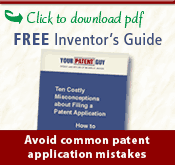Now both the Senate (S.23) and House (H.R. 1249) have passed legislation addressing changes to the US Patent System. Because the legislation is different, further action by Congress is required before President Obama has anything to sign (and he’s indicated he’s inclined to accept reform along the lines of the pending legislation). I will defer a detailed summary of what the law “is” until there is something definite to summarize.
It is looking more likely than in recent past years that there will be some changes to the patent system – and the main points in the both bills include changes to the US “first to invent” system to replace it with a “first inventor to file” system. Most patent offices in the world use the latter system and this is what you sometimes hear when “harmonization” is mentioned – changing to the more common patent standard. (Also in line with harmonization, both bills include language that prohibits using failure to disclose “Best Mode” as a basis to cancel/invalidate a patent or have it be unenforceable. Apparently one must still disclose the Best Mode but it is not clear what the consequences would be for withholding the secret ingredient…)
The other major discussion is about USPTO fee diversion – the USPTO brings in much more revenue that budgeted, and this surplus has been put into the General Fund. The Reform legislation attempts to increase funding for the USPTO by allowing it to use more of the revenue it generates. The purpose of changes related to funding is to increase the budget to help reduce the patent application backlog by examining patent application more expeditiously.
There are other proposals that would have varying impact on the planning and implementation of effective portfolio development and revenue-generation, but we’ll need details. Some proposals are largely symbolic, like the identification of a new class of applicant – the micro-entity. While the official fees for this class of applicant may be further reduced, it is the case that the official fees are rarely the major cost of drafting, prosecuting, and enforcing a patent.
What does all of this mean, practically? For many inventors and small businesses, I predict that a change to a first-inventor-to-file system will not have a large impact. Why? Because the current system in which a patent is awarded to the first inventor to invent required good record keeping legally sufficient evidence to convince a fact-finder that they were, in fact, the first to invent. Ideally this would mean diligent recordation of development, conception, and reduction to practice activities in a special inventor’s notebook and having the entries periodically witnessed by a non-inventor who reads and understands the entries.
(The following is an oversimplification – even so note what I say about archaic and complicated.) The way it plays out in real life is that two inventors each file an application claiming similar subject matter. When the USPTO discovers this, they look at the filing dates of the applications and impose various requirements and burdens on the parties. The inventor associated with the earlier filed application is the Senior Party and the other inventor of the other application is the Junior Party. The USPTO initiates a proceeding called an “interference” in which the priority is determined and the “winner” is awarded the patent. The Junior Party has the burden to prove that they invented before the Senior Party. This is one time when you’d like to have that inventor’s notebook and be able to show that it is credible evidence that you invented first. Most times the Junior Party fails its burden and the Senior Party is awarded the patent. Thus most of the times when there is interfering subject matter, the first inventor to file wins.
It should be mentioned that even in the world of routinely archaic and complicated language and proceedings, the interference is one of the most archaic and complicated (and therefore expensive) proceeding. The Reform language removes “all” of this and replaces the interference with a derivation proceeding (to make sure that an earlier filed application identifies an applicant who was, in fact, and inventor.) What is a derivation proceeding? We don’t know yet, but I suspect it will be a proceeding in which the later-filing inventor will need to show that they are an inventor and maybe that the “Senior” person had access and somehow “derived” the invention from the “Junior” inventor. It sure sounds like a good, well-maintained, inventor’s notebook would come in handy once again.
The “interim” conclusion is that increased funding (if it ends up actually increasing the effective USPTO budget) could help inventors and assignees obtain patents sooner, and for some that is a very good thing. In other respects we don’t see much that significantly benefits the solo inventor or the small business owner.
YPG









Notice: Undefined property: thesis_comments::$comments in /home/k13x1mpx8le9/public_html/ypg/wp-content/themes/thesis_185/lib/classes/comments.php on line 41
{ 0 comments… add one now }